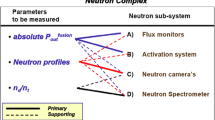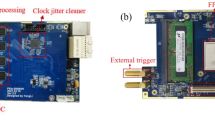Abstract
The neutron flux monitor (NFM) system is an important diagnostic subsystem introduced by large nuclear fusion devices such as international thermonuclear experimental reactor (ITER), Japan torus-60, tokamak fusion test reactor, and HL-2A. Neutron fluxes can provide real-time parameters for nuclear fusion, including neutron source intensity and fusion power. Corresponding to different nuclear reaction periods, neutron fluxes span over seven decades, thereby requiring electronic devices to operate in counting and Campbelling modes simultaneously. Therefore, it is crucial to design a real-time NFM system to encompass such a wide dynamic range. In this study, a high-precision NFM system with a wide measurement range of neutron flux is implemented using real-time multipoint linear calibration. It can automatically switch between counting and Campbelling modes with variations in the neutron flux. We established a testing platform to verify the feasibility of the NFM system, which can output the simulated neutron signal using an arbitrary waveform generator. Meanwhile, the accurate calibration interval of the Campbelling mode is defined well. Based on the above-mentioned design, the system satisfies the requirements, offering a dynamic range of 108 cps, temporal resolution of 1 ms, and maximal relative error of 4% measured at the signal-to-noise ratio of 15.8 dB. Additionally, the NFM system is verified in a field experiment involving HL-2A, and the measured neutron flux is consistent with the results.








Similar content being viewed by others
References
J.W. Yang, Q.W. Yang, G.S. **ao et al., Fusion neutron flux monitor for ITER. Plasma Sci. Technol. 10, 141 (2008). https://doi.org/10.1088/1009-0630/10/2/01
A.J.H. Donné, A.E. Costley, R. Barnsley et al., Chapter 7: diagnostics. Nucl. Fusion 47, S337 (2007). https://doi.org/10.1088/0029-5515/47/6/S07
L. Bertalot, V. Krasilnikov, L. Core et al., Present status of ITER neutron diagnostics development. J. Fusion Energy (2019). https://doi.org/10.1007/s10894-019-00220-w
G. Vayakis, S. Arshad, D. Delhom et al., Development of the ITER magnetic diagnostic set and specification. Rev. Sci. Instrum. (2012). https://doi.org/10.1063/1.4732077
C.J. Tang, C.J. **ao, Y.G. Yao et al., Development of neutron depth profiling system at CARR. Nucl. Tech. 42, 040402 (2019). https://doi.org/10.11889/j.0253-3219.2019.hjs.42.040402. (in Chinese)
Z.J. Liu, Y.W. Yang, L. Zheng et al., Measurement and analysis of the 232Th(n,2n) reaction rate in a polyethylene shell with DT neutrons. Nucl. Tech. 41, 060502 (2018). https://doi.org/10.11889/j.0253-3219.2018.hjs.41.060502. (in Chinese)
B.W. Zheng, C.Y. Jiang, Z.H. Liu et al., Correction and verification of HL-2A Tokamak Bonner sphere spectrometer in monoenergetic neutron fields from 100 keV to 5 MeV. Nucl. Sci. Tech. 30, 159 (2019). https://doi.org/10.1007/s41365-019-0689-9
M. Sasao, A.V. Krasilnikov, T. Nishitani et al., Overview of neutron and confined/esca** alpha diagnostics planned for ITER. Plasma Phys. Control. Fusion 46, S107 (2004). https://doi.org/10.1088/0741-3335/46/7/S08
C.W. Barnes, A.L. Roquemore, Neutron source strength monitors for ITER. Rev. Sci. Instrum. 68, 573 (1997). https://doi.org/10.1063/1.1147656
H.K. Zhang, Y.T. Zhao, A. Liu et al., On-line monitoring of the thermal neutron sensitivity of Co-SPND detector. Nucl. Tech. 43, 040003 (2020). https://doi.org/10.11889/j.0253-3219.2020.hjs.43.040003. (in Chinese)
B.W. Zheng, W. Zhang, T.Y. Wu et al., Development of the real-time double-ring fusion neutron time-of-flight spectrometer system at HL-2M. Nucl. Sci. Tech. 30, 175 (2019). https://doi.org/10.1007/s41365-019-0702-3
G.L. Yuan, Q.W. Yang, J.W. Yang et al., Fusion neutron flux detector for the ITER. Plasma Sci. Technol 16, 168 (2014). https://doi.org/10.1088/1009-0630/16/2/14
M.J. Joyce, M.D. Aspinall, F.D. Cave et al., The design, build and test of a digital analyzer for mixed radiation fields. IEEE Trans. Nucl. Sci. 57, 2625 (2010). https://doi.org/10.1109/TNS.2010.2044245
K.A.A. Gamage, M.J. Joyce, J.C. Adams, Combined digital imaging of mixed-field radioactivity with a single detector. Nucl. Instrum. Methods Phys. Res. Sect. A Accel. Spectrometers Detect. Assoc. Equip. 635, 74 (2011). https://doi.org/10.1016/J.NIMA.2011.01.033
S. Normand, B. Mouanda, S. Haan et al., Discrimination methods between neutron and gamma rays for boron loaded plastic scintillators. Nucl. Instrum. Methods Phys. Res. Sect. A Accel. Spectrometers, Detect. Assoc. Equip. 484, 342 (2002). https://doi.org/10.1016/S0168-9002(01)02016-2
Y.-K. Kim, S.K. Lee, B.H. Kang et al., Performance improvement of neutron flux monitor at KSTAR. J. Instrum. 7, C06013 (2012). https://doi.org/10.1088/1748-0221/7/06/C06013
J. Wu, X. Zhou, C. Yuan et al., A real-time online data acquisition system for Dragon-I linear induction accelerator. Nucl. Sci. Tech. 28, 1 (2017). https://doi.org/10.1007/s41365-017-0182-2
L. Bertalot, R. Barnsley, M.F. Direz et al., Fusion neutron diagnostics on ITER tokamak. J. Instrum. 7, C04012 (2012). https://doi.org/10.1088/1748-0221/7/04/C04012
M. Isobe, K. Ogawa, H. Miyake et al., Wide dynamic range neutron flux monitor having fast time response for the Large Helical Device. Rev. Sci. Instrum. 85, 11E114 (2014). https://doi.org/10.1063/1.4891049
Y. Kaschuck, A. Krasilnikov, A. Alekseyev et al., Neutron flux monitoring system for ITER-FEAT (abstract). Rev. Sci. Instrum. 72, 823 (2001). https://doi.org/10.1063/1.1323487
T. Nishitani, S. Kasai, L.C. Johnson et al., Neutron monitor using microfission chambers for the international thermonuclear experimental reactor. Rev. Sci. Instrum. 70, 1141 (1999). https://doi.org/10.1063/1.1149297
M. Ishikawa, T. Kondoh, T. Nishitani et al., Design of microfission chamber for ITER operations. Rev. Sci. Instrum. 79, 1 (2008). https://doi.org/10.1063/1.2969286
W. Di Wang, H.R. Cao, J. Cao et al., A study of beryllium moderator thickness for a fission chamber with fast neutron measurements. Nucl. Sci. Tech. 28, 1 (2017). https://doi.org/10.1007/s41365-017-0283-y
R.A. Dubridge, Campbell theorem: system concepts and results. IEEE Trans. Nucl. Sci. 14, 241 (1967). https://doi.org/10.1109/TNS.1967.4324422
S.P. Li, X.F. Xu, H.R. Cao et al., Dynamic linear calibration method for a wide range neutron flux monitor system in ITER. Nucl. Sci. Tech. 24, 8 (2013). https://doi.org/10.13538/j.1001-8042/nst.2013.04.002
H.R. Cao, S.P. Li, X.F. Xu et al., An automatic gain adjustment Campbell integrator for neutron flux detection in ITER. Nucl. Sci. Tech. 23, 114 (2012)
Y. Endo, T. Ito, E. Seki, A counting-campbelling neutron measurement system and its experimental results by test reactor. IEEE Trans. Nucl. Sci. 29, 714 (1982). https://doi.org/10.1109/TNS.1982.4335943
N. Qiao, D. Li, H.S. **ong, Research on fission chamber signal simulation of wide-range nuclear instrument system. At. Energy Sci. Technol. 47, 1892 (2013)
J.W. Yang, X.Y. Song, W. Zhang et al., Development of prototype neutron flux monitor for ITER. Plasma Sci. Technol. 7, 2860 (2005). https://doi.org/10.1088/1009-0630/7/3/018
Author information
Authors and Affiliations
Corresponding author
Additional information
This work was supported by the National Natural Science Foundation of China (Nos. 11475131, 11975307, and 11575184) and the National Magnetic Confinement Fusion Energy Development Research (No. 2013GB104003).
Rights and permissions
About this article
Cite this article
Zhu, RJ., Zhou, X., Liu, ZH. et al. High-precision and wide-range real-time neutron flux monitor system through multipoint linear calibration. NUCL SCI TECH 31, 94 (2020). https://doi.org/10.1007/s41365-020-00798-3
Received:
Revised:
Accepted:
Published:
DOI: https://doi.org/10.1007/s41365-020-00798-3




